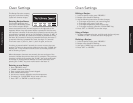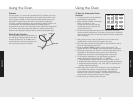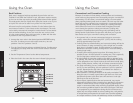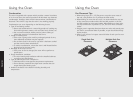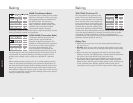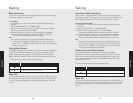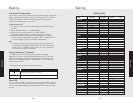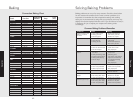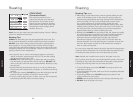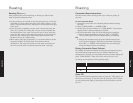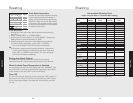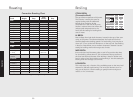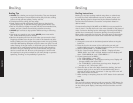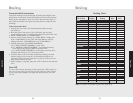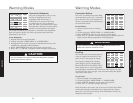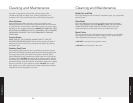
45
Operation
44
Operation
CONV ROAST
(Convection Roast)
The convection element runs in
conjunction with the inner and outer
broil elements. This transfer of heat
(mainly from the convection element)
seals moisture inside large roasts. Use
this setting for whole turkeys, whole
chickens, hams, etc.
Note: You can also roast foods using bake settings. See the “Baking”
section for additional information.
Roasting Tips
ALWAYS
use the broiler pan and grid supplied with each oven. The
hot air must be allowed to circulate around the item being roasted.
DO NOT cover what is being roasted. Convection roasting seals in
juices quickly for a moist, tender product. Poultry will have a light,
crispy skin and meats will be browned, not dry or burned. Cook meats
and poultry directly from the refrigerator. There is no need for meat or
poultry to stand at room temperature.
• As a general rule, to convert conventional recipes to convection
recipes, reduce the temperature by 25°F (-3.9°C) and the cooking
time by approximately 10 to 15%.
•
ALWAYS
roast meats fat side up in a shallow pan using a roasting
rack. No basting is required when the fat side is up. DO NOT add
water to the pan as this will cause a steamed effect. Roasting is a dry
heat process.
• Poultry should be placed breast side up on a rack in a shallow pan.
Brush poultry with melted butter, margarine, or oil before and during
roasting.
• For convection roasting, DO NOT use pans with tall sides as this will
interfere with the circulation of heated air over the food.
• If using a cooking bag, foil tent, or other cover, use the conventional
bake setting rather than either convection setting.
Roasting
Roasting Tips (cont.)
• When using a meat thermometer, insert the probe halfway into the
center of the thickest portion of the meat. (For poultry, insert the
thermometer probe between the body and leg into the thickest part
of the inner thigh.) The tip of the probe should not touch bone,
fat, or gristle to ensure an accurate reading. Check the meat
temperature halfway through the recommended roasting time. After
reading the thermometer once, insert it 1⁄2 inch (1.3 cm) further into
the meat, then take a second reading. If the second temperature
registers below the first, continue cooking the meat.
• Roasting times ALWAYS vary according to the size, shape and quality
of meats and poultry. Less tender cuts of meat are best prepared in
the conventional bake setting and may require moist cooking
techniques. Remove roasted meats from the oven when the
thermometer registers 5°F (-15°C) to 10ºF (-12°C) lower than the
desired doneness. The meat will continue to cook after removal from
the oven. Allow roasts to stand 15 to 20 minutes after roasting in
order to make carving easier.
For many foods, especially roasts and poultry, internal food temperature
is the best test for doneness. The meat probe takes the guesswork out
of roasting by cooking foods to the exact doneness you want.
Note: Double oven models have a probe in the upper oven only.
Use of probes other than the one provided with this product may result
in damage to the probe. Use the handles of the probe and plug when
inserting and removing them from the meat and outlet.
• To avoid damaging your probe, DO NOT use tongs to pull on the
cable when removing.
• To avoid breaking the probe, make sure food is completely defrosted
before inserting.
• To prevent possible burns, DO NOT unplug the probe from the
outlet until the oven has cooled.
• NEVER leave the probe inside the oven during a self-cleaning cycle.
• DO NOT store the probe in the oven.
Roasting



